Whilst dark matter is one of the most elusive stuff in our universe, the top quark (the heaviest of all known particles) is one of the favorite probes to unravel new phenomena. Therefore, the temptation to merge these two concepts is huge.
Doing so gives rise to what we call top-philic dark matter.
As a disclaimer, 'top-philic' is by no means an insult (at least in physics), and I will explain below what it exactly means.
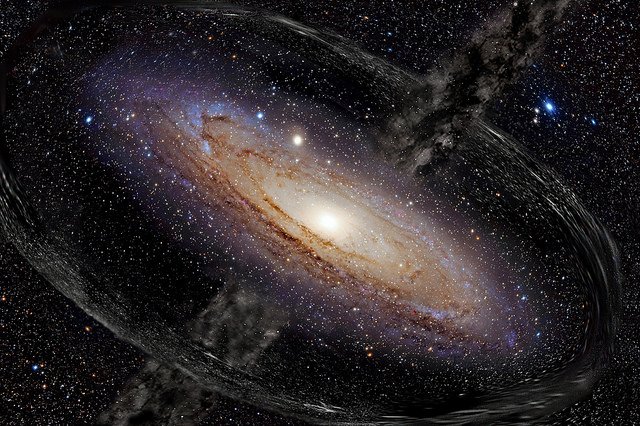
[image credits: Maxwell Hamilton (CC BY 2.0)]
In this post, I discuss one of my recent works on dark matter, that appeared two days ago on the arxiv.
My collaborators and I have chosen to study a specific class of dark matter particle, that is... surprize surprize... top-philic.
And to describe (theoretically) how this dark matter particle behaves, we need... a top model (well…).
In practice, we have designed one of the simplest models featuring this top-philic dark matter, and we have investigated how viable it was after accounting for all existing experimental data.
TOP-PHILIC DARK MATTER
So, what is this ‘top-philic dark matter’ beast? Let’s first start with the dark matter part. Darkness comes before top models…
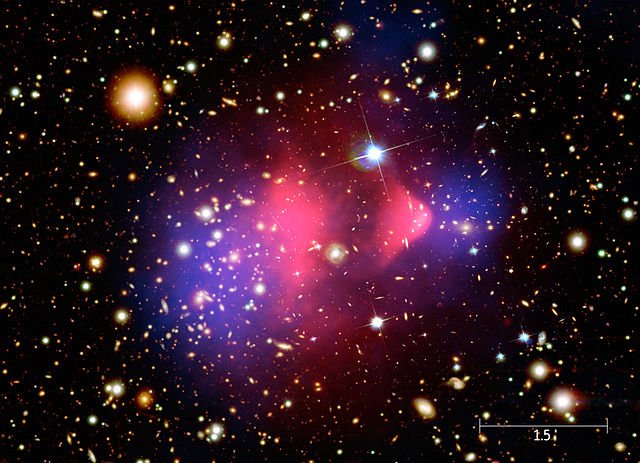
[image credits: NASA (public domain)]
In the early 1930s, it was observed (in this scientific article) that the motion of the galaxies was not matching the expectation from gravity and the visible stars.
In order to restore the agreement between theory and data, some invisible gravitational mass was postulated.
This is what is known as dark matter. It is dark, as invisible and thus not sensitive to electromagnetism (that is connected to light), and it is feels gravity, like normal matter.
Whilst this may sound artificial, plenty of extra evidence appeared in the meantime. We can talk about the observation of the cosmic microwave background, the large structures in the universe and gravitational lensing, and so on.
Whereas we have plenty of indirect proofs of different nature, there is so far no direct observation of dark matter (even if we try hard). This is not so dramatic for the moment, as there exist many options for dark matter to actually evade our tests.
Now let us move on with the top quark.
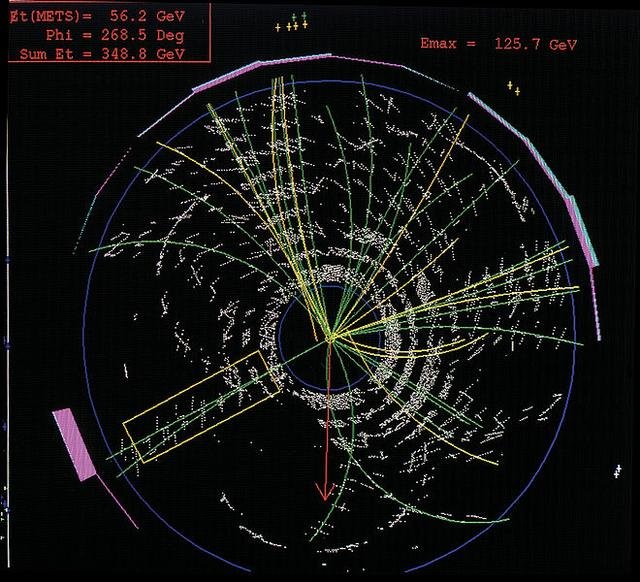
[image credits: Fermilab (public domain)]
I will not provide a full lecture on the Standard Model of particle physics, which describes how all the elementary particles live, drink and dance. For this, please see here.
I will instead recall that atoms are made of electrons, protons and neutrons, and that protons and neutrons are made of quarks.
Although two different quarks would have been enough, Nature was funky enough to allow for six of them.
The heaviest of all quarks is the top quark, that is also the heaviest fundamental particle.
The important point is that by virtue of its large mass, the top quark is widely considered as connected to new phenomena (that includes dark matter).
THE DARK MATTER RELIC ABUNDANCE
As stated in the beginning of this post, my collaborators and I coined a very simple model describing top-philic dark matter. But is it viable with respect to data?
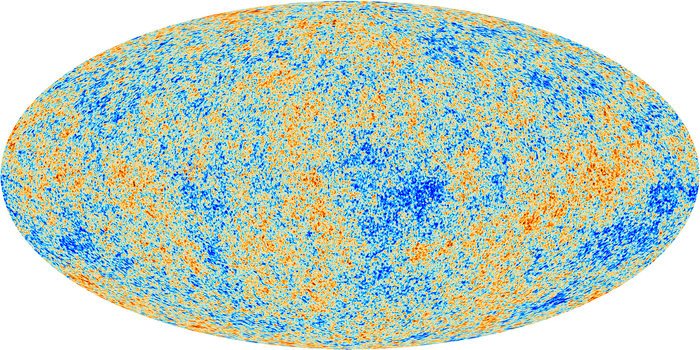
[image credits: ESA (public domain)]
In its early days, our universe could be seen as a cosmic soup in which particles (including dark matter) were created (from other particles) and annihilated (into other particles) in equal amounts.
With its expansion and cooling down, there however exists a moment at which our universe was not hot enough to yield dark matter creation.
There also exists another moment at which the universe has expanded too much for dark matter particles to find each other and annihilate.
As a consequence, any dark matter particle present at this last time is still there today. This is what we call the relic density of dark matter.
By investigating the cosmic microwave background (the above picture), it is possible to derive the relic density from data. Similarly, we can make predictions for the relic density in the context of our top-philic dark matter model and therefore constrain the model.
DARK MATTER DETECTION
There is a plethora of dark matter experiments on Earth, trying (so far unsuccessfully) to detect the dark side. We must ensure that our model does not predict any signal that should have already been observed.
In direct dark matter detection experiments, one tries to measure the recoil of an atomic nucleus hit by a dark matter particle. Whist these events are very rare as dark matter very weakly interacts, one usually expects to see some of them assuming typical dark matter models.

[image credits: NASA (public domain)]
In indirect dark matter experiments, one studies cosmic rays to unravel any potential signal originating from the annihilation of dark matter.
One option consists of looking for spheroidal dwarf galaxies, a class of galaxies that contain a lot of dark matter.
The latter could indeed be connected to specific cosmic ray signals to be observed on Earth.
PRODUCING DARK MATTER AT COLLIDERS

[image credits: CERN]
One can also search for dark matter at particle accelerators, like the Large Hadron Collider at CERN.
Whilst dark matter is invisible, one can actually ‘observe’ it (note the quotes).
The key point consists in using the conservation of the energy (and the momentum) to reconstruct what is invisible.
First, one can produce invisible dark matter together with some highly energetic visible object, and study the properties of the latter to get information on dark matter.
Second, one can directly produce the mediator connecting dark matter to the top quark. This mediator is typically unstable, and decays into visible particles and invisible dark matter. Once again, one gets information on the invisible by studying the visible stuff.
SUMMARY AND TAKE HOME MESSAGE
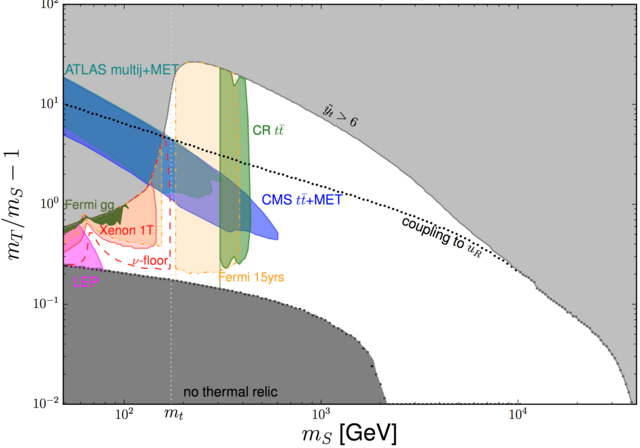
[image credits: Inspire]
In this article, we have studied one of the simplest model of dark matter in the case where it is connected to the heaviest of all known particles, the top quark.
We have verified that the right relic abundance of dark matter could be accommodated, and that no signal observable in direct and indirect dark matter detection and collider experiments was predicted.
The findings are summarized in the figure, the white zone being allowed by all data.
We thus still have a long way to go before killing the model!
In order to understand what dark matter is, we need to search for it in all possible ways. This is what we have done here, for a specific class of models.
Once again, some stupid stuff is hidden in this post… Can you find it? And I don't talk about the title of the post that is very serious.
STEEMSTEM
SteemSTEM is a community-driven project that now runs on Steem for more than 1.5 year. We seek to build a community of science lovers and to make the Steem blockchain a better place for Science Technology Engineering and Mathematics (STEM).
More information can be found on the @steemstem blog, on our discord server and in our last project report. Please also have a look on this post for what concerns the building of our community.
I might be wrong, but I do have a feeling that scientists are disappointed by the lack of new findings. It's somehow felt in the way that latest studies are written and news items are covered. I am talking about supersymmetry, but there are other subjects I have read.
What I really like about the progress is that all of you methodically poke it from all sides in the hope that it gives you more insight into how it behaves and at what energy levels. This is what I like about the scientific method and I really hope that you find it. Or something else that will challenge the model even more :P
First, I am not disappointed. Most theories cannot be unravelled at the LHC, and deviations from the Standard Model may still hide. There is no guarantee to find anything. However, one knows where to look for deviations and new phenomena, and designing techniques to unravel them is interesting as such.
Second, we have not found anything new, that is true. But there is a bunch of intriguing puzzles that we should try to explain somehow without ruining the fact that we have not found any new particle. And this is not an easy task.
To come back a minute on supersymmetry, there are actually many many theories that could extend the standard model. Supersymmetry is one class of them, and only a tiny fraction of all supersymmetric concrete realizations is actually excluded by data.
The important point today is to investigate which models are more likely to be viable, and how to test the remaining ones better. This task is enormous, and much more complicated than if we had a new particle to start with. It is also a good time to learn about the different existing paradigms, try to see how one could test them simultaneously, etc.
So yes, there may be no new Nobel prize in a close future. But the amount of physics to be studied is just enormous. We have data coming from everywhere, and even null results give strong indication on what new phenomena could be or could not be. What is clear is that the Standard Model is not complete. But how to complete is still unknown, and we have actually no clue on how to do that. Therefore, all options must be tried!
I know!
It was bound to get harder sooner or later. The time of discovering things as a hobby is long gone.
I understand the monumental task and I really can't wait to see the Standard Model being updated. I might not understand all that I read in this field, but I still want to know the answers, when they are discovered :P
Congrats on getting work published. That's always nice!
Hopefully we will see something during our lifetime. There is no guarantee on this :D
Sry, I am not a physicists at all and therefore my question may sound stupid or pointless to you. (My most intense contact with physics was physical chemistry, so quite a big leap to your presented work here.)
In which sense would two quarks be enough to constitute matter? Would really only two quarks allow to define properties of our surroundings like they are right now, or would two would be enough do define 'some kind of matter' but with different distinct properties?
I hope, I was able to express my question understandably!
Best,
mountain.phil28
There is no pointless question. Only pointless answers :)
Maybe the best way to answer your question is to point to this link. I guess you will get all answers in there (if not, please come back to me).
Cheers!
Thanks for the response and link!
My pleasure!
This is pretty much an interesting expose on dark matter @lemouth. And it sure dwarfs a lot of the seemingly fictional theories bandied about in most Sci-fi movies about dark matter.
However, some pointers in this post caught my attention, and hence these (perhaps, irrelevant ) questions.
Q1: So, does this mean that the hotter the universe gets (solar radiation, warming and all), the quicker or faster the creation of dark matter and its subsequent movement?
Q2: At the rate of expansion and drifting of the universe, does it rule out the eventual chance or possibility of the natural formation of the dark matter?
Thanks for passing by Rickie. Let me try to answer your questions.
A very hot universe means a lot of energy to create some pairs of particles. However, those freshly created guys were usually meeting their 'partner' quite quickly and turning back into energy. We had both the creation and annihilation processes in equal quantity.
With the expansion of the universe, the temperature cooled down and there was at some point not enough energy locally available to allow for the creation process. So that only annihilation was working and the global density of dark matter were thus going down. But at some point, the annihilation process stopped too. Then, the dark matter density freezes out.
You can probably find more information here.
Does it help?
Oh yea! Thanks, this really helped @lemouth, including the previous post. I believe I now grasp the theory better now, especially with your precise and succinct answers. Thanks.
You are welcome! :)
It's really a pleasure to learn about the awesome experiments going on to understand the existence of dark matter.
As you said, dark matter is so less interacting that we cannot perceive it by our present equipments. But mathematically it's present in galaxies which makes them more massive than they are and is a key element in keeping the stars from flying away from the galaxies spinning at high speed.
Yeah, the experiment to detect dark matter with the help of top quark is quite promising. Maybe in future we such sensitive equipments and methods to observe the relic abundance of dark matter.
Actually, after reading this I am inspired to write a post about dark matter discussing about it as a story for casual readers. :)
Thanks @lemouth for sharing your research and other experiments going on about dark matter.
I think this is what you are talking about:
(Check the link) :D
It was a long time! Happy to see you are still around! And that you got my top model :D
By the way, there may still be no dark matter but modified gravity instead. This option is not excluded (yet :p).
Yeah, it is possible that the reality is different from the proposed dark matter model. I hope we'll soon find it as scientists like yourself are doing such great research and experiments. :)
i hope too! However, one should not underestimate physicists' imagination to resurrect zombies :D
Yeah. :D
Okay, this might be a dumb question but I have to make it: could we essentially touch dark matter even though it is not electromagnetically interacting?
So I get that they basically gather data regarding energy and momentum variations in the system and then create a virtual model? Correct me If I'm wrong. (I know you would :P).
That was a wonderful, glamorous blog!
See what I did there??
Keep up the great work!Thank you for your efforts, @lemouth!
Dark matter can be sensitive to weak interactions, or even to new forces. It can also interact with the Higgs boson. Those are varied option to make it interacting (always super weakly) with the particle of the Standard Model.
It is actually different. One is colliding two particles along a so-called collision axis (that we may call the z-axis to fix the ideas). In the initial state, there is thus exactly zero momentum in the transverse plane (the Oxy plane) since our colliding particles do not move within this plane.
Now let us move on with the final state. ,Our detectors investigate what is going on transversally to the collision axis (i.e. in the Oxy plane) because the proton remnants pollute what is going on along the z-axis. From the detector records, one can reconstruct the final state and measure the total amount of transverse momentum in it (the amount of momentum along the Ox and oY directions).
By momentum conservation, we know in advance that this transverse momentum must vanish. If however often does not. Therefore, we calculate what is missing to make it vanishing. This is the missing momentum which we associate with dark matter in our case. The missing transverse energy is the norm of this vector.
Is it clearer?
Well, it's a lot clearer now, thank you for taking the time to leave such a detailed response. I just wish I could reward your response accordingly.
I get that proton remnants have no effect in the Oxy plane, thus the amount of momentum in this plane that vanishes due to momentum conservation is considered to be somehow related to the presence of dark matter.
I think I got it, right?
Again, thanks for this mini 'private' lecture, lol!
This is a very good summary. Just to emphasize: we measure the total momentum in the transverse plane (Oxy) and what is missing so that the sum of all contributions from all particles is called the "missing transverse momentum". This could of course come from neutrinos, but if the amount is large, this may be connected to dark matter. At the end, it is a matter of confronting predictions of the Standard Model to data and see whether we have room for dark matter or not. So far: nothing non standard :(.
Why do I always start your post by looking for that something "stupid" which may be hidden somewhere on the post? :)
I'd say I think the models are just what a nerd needs :D
Out of curiosity, is there a reason for the quark which is the heaviest subatomic particle to be the top quark? Shouldn't quantum gravity make it the bottom quark?
Because this is a funny game? :D
First of all, the top quark is the heaviest because nature has decided... We don't know why the masses of the quark are what they are. They are proposals trying to explain the patterns, but so far these are all hypothetical.
Quantum gravity has in contrast nothing to do here, as gravity is not included in the Standard Model. For the moment, there is no satisfactory theory unifying all 4 fundamental interactions in a unique framework. I have however not understood the reason of your question. Why would quantum gravity make the bottom quark heavier?
Oh, I was playing around with the idea of the larger the object, the higher the gravitational attraction between them. So I thought the heavier particle would be the one at the bottom. There is a lot of assumptions going on in my head when I asked the question :)
The names have nothing to do with the size. All those guys are elementary particles at the end of the day. without any substructure. The bottom quark is in fact the next-to-heaviest.
That explains it then. Thanks a lot.
You are welcome then! :)
Very clear here
Thanks! :)
Before now, I have always believed that dark matter exists only in theory, but I guess I was wrong.
I've also leant why they are called dark matter; because they cannot interact with electromagnetism.
Thanks for sharing sir.
P.S: I could detect some hidden unrelated details you made mention of sometime ago :D
No no, you are correct. All the evidence we have are indirect. Dark matter explains them, but other different explanations are possible as well.
PS: glad you found it :D
Wow! I'm actually correct :)
I feel so happy to hear that :D
Very interesting post, @lemouth. Great job with making some very complex research understandable by even people who don't know much about physics! And I'm glad you convinced the your collaborators to publish in a freely available format. I gave the article a quick glance, but there's no way way I will ever understand even 5 % of that one ;) Hehe
No matter where the article is published, we actually don't really need any journal as it will stay on the arxiv. However, journals are important for peer-reviewing. Therefore, se should just pick any option where anyone (yes anyone) could get the paper for free. I am fighting for this for several years. :)
Oh, I didn't realize that arxiv was non-peer-reviewed. But it's great to hear that you are fighting for making the papers available for free. I'm very politically opposed to having any scientific paper hidden behind a paywall (that can often get extremely high for people who just wants to catch up on some science), and I truly believe that it should all be available for free. I guess the journals themselves need to make some money, but charging $50+ for a single article is a bit outdated in my opinion.
You need to be endorsed to submit on the arxiv, but this is very easy to get as long as you work with someone from the field.
I fully agree with this! I am now even refusing to write referee reports for non-open-access journals. That is of course very little, but we need to start somewhere, don't we?
This is good work.... Have been seeing and hearing about in different movies and books
Now it's very clear but u still need to see previous post about it.....is Dark matter an energy..... I really can't place it
Dark matter is not an energy. A dark matter particle has some energy depending on how it moves (mass energy, kinetic energy, etc.). Energy and particles are not the same thing. Does it clarify?
Yea..... I get it now
Don't hesitate to come back to me if you have any other question! :)
Yes sir
I've learnt from this that Darkness comes before top models.
Would need to take a deep look into the post you wrote on the Standard Model of particle physics.
Keep the great work you do for the Steemstem community on this blockchain.
Also I actually didn't realise dark matter was visible and observable I've got so much to learn from you @lemouth. Signed member of @euronation
Dark matter is invisible, but can be observed in one way or the other. We can reconstruct the invisible through its effects on the visible. This is the whole idea ;)
Thanks for your nice comment!
Wow this is purely scientific and mind blowing I need to keep tabs on your blog to learn more from the co founder of SteemSTEM.
Thanks Sir for finding time to reply my comment this means so much.
Stay blessed.
Wow this is a very nice comment! Thanks a lot! :)
I will always take time to answer anyone who has questions (about what I know of course).
If I simply say 'Great Post' , it could be categorised under spamming.. But the fact is that I have nothing to say more than that! Really great and I have learnt something new about dark matter and top quarks and their possible relationship. Thank you @lemouth
Thanks a lot for passing by, and writing a kind of comments containing more than two words! This is appreciated ^^
Hi @lemouth! Any word to express the appreciation for presenting this awesome article will be very small as compared to the work you done it in this post. 😇
Thanks a lot for this post!! It's like a real gem for me.. I haven't seen any such kind of quality rich STEM article till date! As usual I will learn a lot from this as well.. 😇
I guess you remember when I asked you a query about Dark Matter and you explained me about that. But oh my goodness you made it a lucky day for me reading this post!! Thanks. :)
The pleasure was for me, believe me. I always enjoy writing about my work! Thanks for passing by and the nice comment ;)
It's my pleasure @lemouth! I learnt a lot from you and looking forward in learning more from you.. It's always a pleasure chasing our interest of knowledge!! 😇
If I'm not mistaken, I've read that:
Dark energy will also change our understanding of the fate of the universe forward. In the Cosmology Standard Model, the fate of the universe is determined by its geometry. If the geometry of the universe is spherical geometry (with the density parameter Ω> 1), the universe will continue to expand until a certain moment, then stop expanding, and begin to collapse. If the universe has a flat geometry (with parameter density Ω = 1), the universe will expand and continue to expand at speeds approaching zero. And if the universe has a hyperbolic geometry (with density parameters Ω <1), then the universe will continue to expand with the speed of development approaching a certain speed that is not zero. The three possible ends of the universe have in common, that the universe expands with ever smaller developmental powers.
How do you think about this?
Well, this has nothing to do with my post. But to answer your question, data points out that the universe is mostly flat. Then you have your answer. This being said, alternative exists, in which the cosmology is not standard.
Yes, I got it in one of the books. A student asked me about it. Incidentally I see your writing is not much bed with this problem so I am applying for you. Thanks for the respon.
Your said :
Is not cosmology entering a new phase. Various observational findings give us a current picture of the universe, which is somewhat different from the universe as illustrated by the standard model of cosmology.
In my coment :
I can not think if then the earth will shrink ... oh can not be imagined.
Do you mind specifying? Standard cosmology damned well agree with most data. At least way better than what any potential alternative does.
Don't worry, we will all be dead for a long time at that moment as Earth will already have been destroyed by the Sun ;)
I think... Alternative cosmological scenarios exist, which can produce a spectrum close to the cosmological invariance scale that is still random to explain the details of the CMB anisotropy spectrum. Most pentuing, alternative models can be distinguished from inflation within the framework of observation. The use of ground-based and satellite-based telescopes in the coming years will greatly help improve CMB mapping results as well as prove one of the alternative models or even provide new challenges particularly in regard to the physics that approach the Planck scale.
If then this is associated with a standard cosmology maybe this will be more perfect.
I have never said alternative cosmologies were not existing. They are models, and they are well alive. For these reasons, they deserve to be studied. Anything that is not excluded deserves to be studied. And the future will tell us what is viable and what is not. Personally, I prefer the standard cosmological model, because it is simpler. Anything simple is always good. But maybe this will not survive future data :)
The simple conclusion, a law of physics that has not been discovered causes the cosmological constant to disappear. But while many theorists love this constant to go, various astronomical observations-over the age of the universe, the density of matter, and the nature of the cosmic structure-all separately indicate that it may still exist.
Congratulations @lemouth! You have completed some achievement on Steemit and have been rewarded with new badge(s) :
Click on any badge to view your own Board of Honor on SteemitBoard.
To support your work, I also upvoted your post!
For more information about SteemitBoard, click here
If you no longer want to receive notifications, reply to this comment with the word
STOPYep, this happens :D
Don't convince the readers you did not mean to insult them with the word 'top-philic', a well known swearing word lol
And awesome to hear about your recent work and submission to arxiv!
If someone is top-philic, this means this someone lies what is top-like, This is by no means an insult, come on! Who does not like a good top model :D
Yep, tomorrow will be the (open access) journal ^^ Just one request asking for a couple of citations (I didn't say I will accept the request).
Hi, I found some acronyms/abbreviations in this post. This is how they expand:
Hey! CC is wrong, and there is no VAB abbrevitation in the post... :)
It seems @acronyms is not functioning well, I have seen it making such mistakes like this in the past. Reading about 'dark matter' for the first time. Well done sir, guess you are 'Laura Lopez Honorez'?
Good try, but I am not Laura. ^^
Lol, I will not guess again till I know it.
16% of chances (1 out of 6) :D But come on, I am not a girl... this should be known by now! This brings your chances to 25% ;)
You don't seem like a Stefano Colucci :D
In fact I would go with a French name vs an Italian one.
Congratulations, your post has been selected for TecNews! Thank you for your contribution!
Thanks! :)
Nice post beautiful .plzz follow me
This is not something that should be asked.
Write great and original content articles and join a community. This is regarded as spamming!. @kamrankami
This got me laughing.@lemouth
Can’t believe I started looking for something stupid that’s hidden in the post 😂😂😂
Why? Is it because you live, drink and dance? :D
Please do! No one has found it so far! :D
😂😂😂😂
Hey, just wanted to let you know I gave you an upvote because I appreciate your content! =D See you around
Thanks a lot!
Hey, I don't have anything really insightful to say as I am a newbie when it comes to astrophysics, but I love to read about the topic, so thanks for writing good content on the topic! :)
The pleasure is for me! Thanks for passing by! :)
Interesting!
Isn't it? This is why I wrote about (twice actually ;) ).
wow... Very exciting and adventurous. i really love cosmology and i just want to know about dark mater and dark energy and i know finally the destination of this world will be determined by discover of the 2.
I don't write about dark energy as we can't work on everything (there is only 24 hours in a day, and 7 days in a week :) ). I am not sure this will change anything for the state of our world. but at least this will help us to understand how our universe works.
Thanks for your comment!
I have no opinion as I didn't know about it until you mentioned its name. By quickly browsing the page (just back from an offline moment and I have very little time at the moment), it seems that vortex science disagrees with some experimental facts. I find it surprising.
Anyways, it seems that there is no published work on this model. Maybe I am wrong, then please refer it to me. But without any article backing it up, this means the theory has not been confronted to peer-review. Therefore...